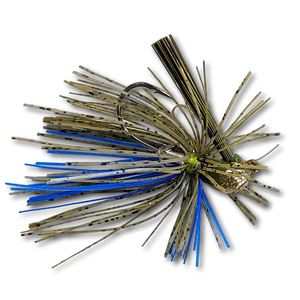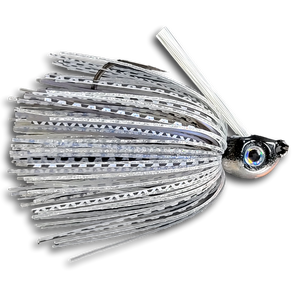Grass jigs are specialized jigs designed for fishing in and around dense vegetation. Their pointed or bullet-shaped heads allow them to penetrate thick grass mats and glide through vegetation without snagging. Equipped with sturdy weed guards, heavy-duty hooks, and silicone skirts, grass jigs provide the perfect combination of toughness and finesse to tempt fish lurking in heavy cover.
The added skirt and trailer enhance the jig’s lifelike movement, mimicking crawfish, baitfish, or other prey that bass feed on. Grass jigs are especially effective for targeting aggressive bass that use vegetation as cover for ambushing prey.
Grass jigs are incredibly versatile and can be fished using a variety of techniques to match the conditions:
Flipping and Pitching: The most common method for fishing grass jigs is flipping or pitching them into heavy vegetation, such as grass mats, reeds, or submerged weeds. Let the jig sink to the bottom, then use subtle hops or shakes to mimic natural prey.
Punching: When targeting fish under thick surface mats, use a heavier grass jig to punch through the cover. This technique excels in the summer when bass seek shade and cooler water below dense vegetation.
Swimming: Grass jigs can also be retrieved steadily through sparse vegetation or along grass edges. Pair them with a swimbait trailer for added action and to mimic baitfish swimming through the area.
Hopping: Use small hops or lifts to trigger strikes when fishing grass jigs near isolated grass patches, points, or holes in the vegetation.
Dragging: In less dense grass or along the edges of vegetation, drag the jig slowly along the bottom to mimic a crawfish or baitfish moving naturally.
Grass jigs excel in heavy cover but are versatile enough to be used in other situations. Here’s a breakdown of their seasonal effectiveness:
- Spring: During the pre-spawn, target bass in shallow grass beds, reeds, or vegetation near spawning areas. Flip or pitch grass jigs into likely ambush points.
- Summer: Grass jigs shine in the heat of summer when bass seek shade under thick mats. Use heavier jigs to punch through surface cover or swim jigs along deeper grass edges.
- Fall: Grass jigs are perfect for fishing shallow vegetation or riprap where bass are feeding aggressively. Swim or hop the jig through grass lines to mimic baitfish or crawfish.
- Winter: While less common in colder months, grass jigs can still be effective when fished slowly in sparse vegetation or along deeper grass edges.
Grass jigs are ideal for lakes, ponds, and rivers with abundant vegetation, including hydrilla, coontail, milfoil, and lily pads.
Best Colors and Trailers for Grass Jigs
Selecting the right color and trailer for your grass jig is essential to matching the conditions and forage:
- Clear Water: Natural colors like green pumpkin, watermelon, and brown mimic crawfish or baitfish effectively.
- Stained or Murky Water: Bright or high-contrast colors like black and blue, chartreuse, or junebug improve visibility.
- Low-Light Conditions: Use darker colors like black or purple to create a strong silhouette.
Pairing your grass jig with the right trailer enhances its action:
- Craw Trailers: Perfect for flipping and punching, these trailers add lifelike claw movements that mimic crawfish.
- Swimbait Trailers: Ideal for swimming jigs along grass edges or through open pockets.
- Creature Trailers: Great for creating bulkier profiles and adding extra movement to your presentation.
- Chunk Trailers: Best for slower presentations or when targeting larger bass in heavier cover.
Why Grass Jigs Are So Effective
Grass jigs excel because they are specifically designed to handle heavy cover and thick vegetation where other lures fail. Their weedless design allows them to penetrate dense grass while minimizing snags, ensuring you can reach bass hiding in hard-to-access areas.
The combination of a skirt and trailer provides lifelike movement that mimics natural forage, while the heavy-duty hook and weed guard give anglers the confidence to fish aggressively without worrying about losing fish in the cover.
Tips for Fishing Grass Jigs
- Gear Up for Heavy Cover: Use a heavy-action rod and braided line (30-65 lb test) to handle the weight of the jig and the strength of fish pulling into dense vegetation.
- Perfect the Hookset: When fishing in heavy grass, a strong, deliberate hookset is crucial to driving the hook through the weed guard and into the fish’s mouth.
- Target Key Areas: Focus on holes in grass mats, edges of vegetation, and isolated patches of grass where bass are likely to ambush prey.
- Match the Hatch: Choose colors and trailers that closely resemble the local forage to increase your chances of success.
Grass jigs are an essential tool for anglers looking to target big bass in heavy vegetation. Their streamlined design, weedless features, and lifelike presentation make them one of the most reliable lures for fishing dense cover. Whether you’re flipping into thick mats, punching through surface vegetation, or swimming along grass edges, grass jigs deliver consistent results. Stock up on your favorite colors and trailers, and let these powerful jigs help you tackle the toughest cover with confidence.
Qwik Catches!







